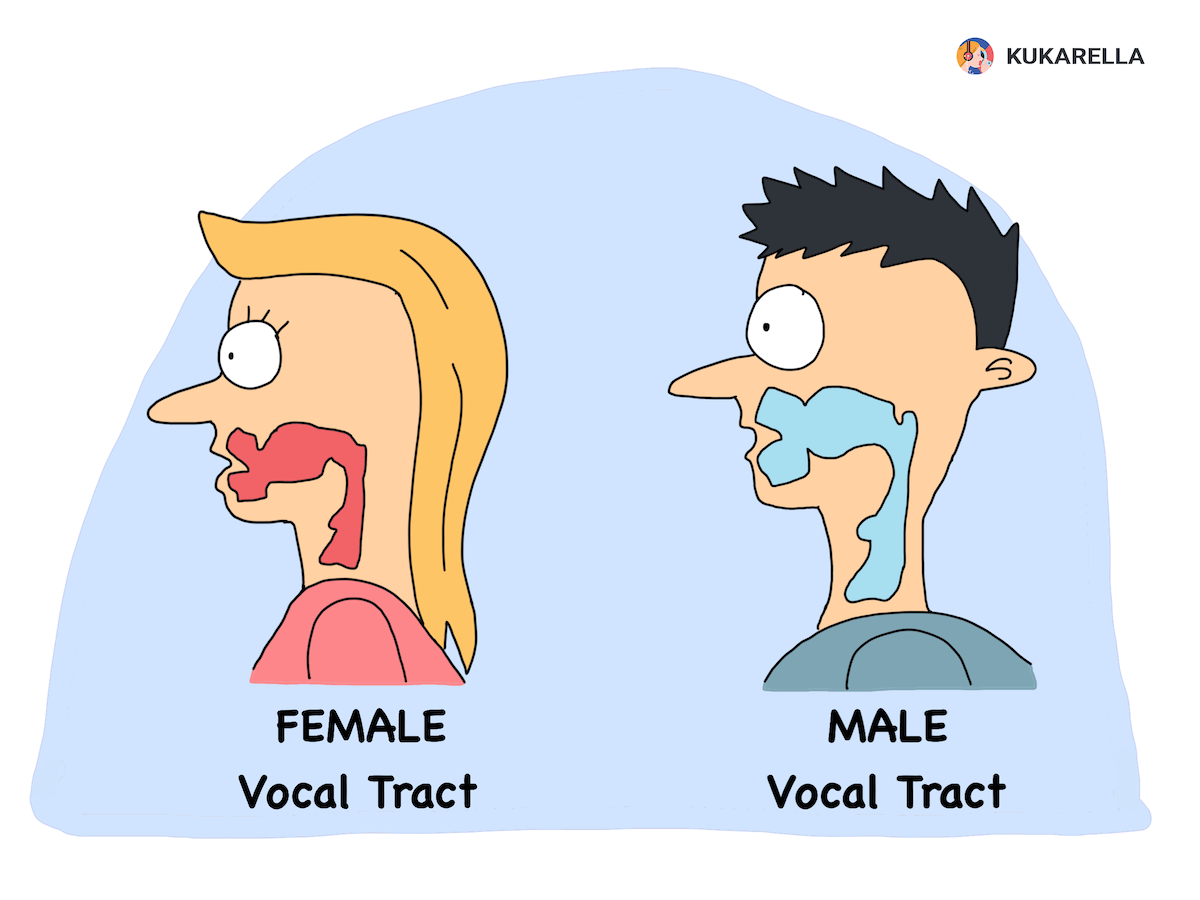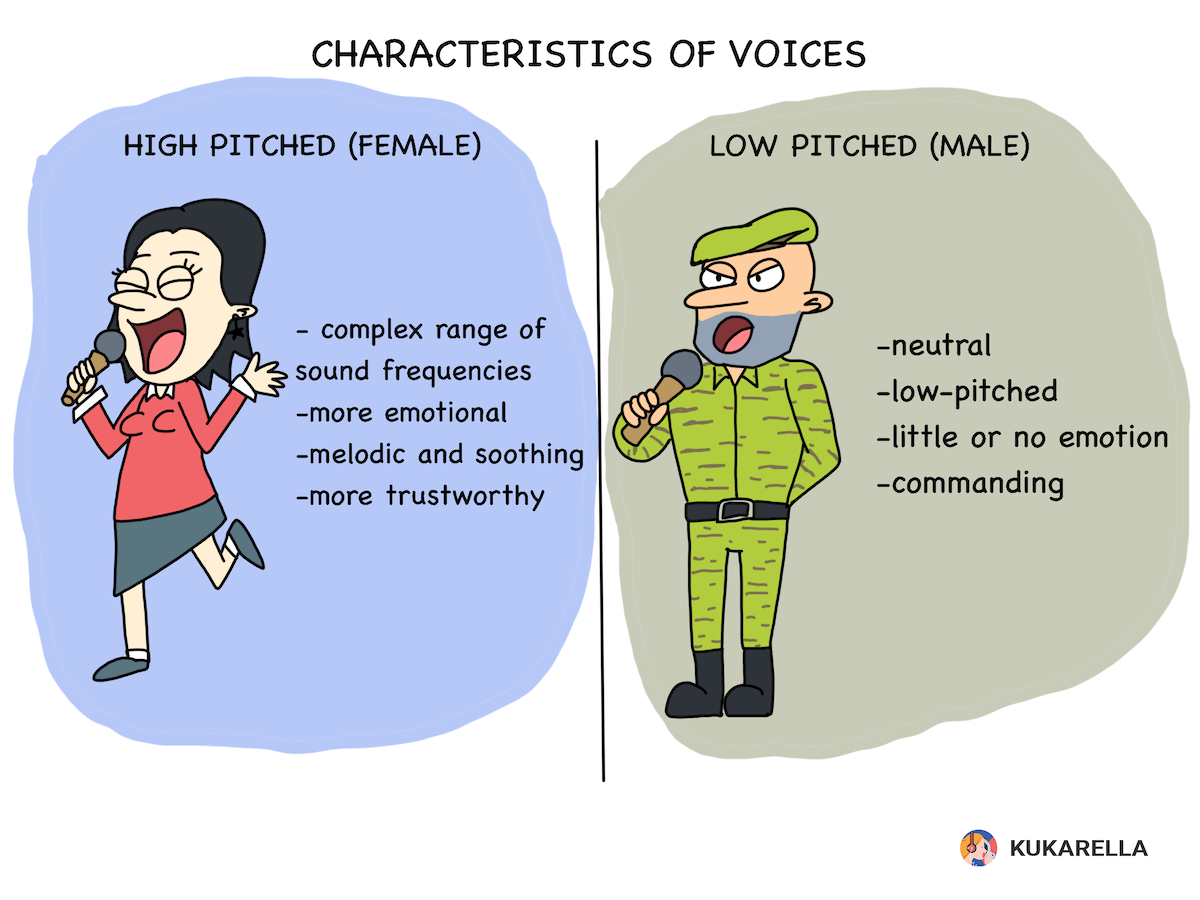Remember the moment from Back to the Future when Marty woke up in a strange house? What woke him up? His mother's voice. How did it affect him? This immediately created a sense of peace and reliability, which within seconds was comically shattered when Marty saw a teenage girl next to him.
<iframe width="560" height="315" src="https://www.youtube.com/embed/pG5C41GcqE4" title="YouTube video player" frameborder="0" allow="accelerometer; autoplay; clipboard-write; encrypted-media; gyroscope; picture-in-picture" allowfullscreen></iframe>
It was not about age, but about the voice. Even though the girl was a teenager in this scene, her voice possessed all the characteristics that a mother’s, or rather a woman’s, possesses. What are these characteristics?
Due to simple anatomical differences, a woman’s voice is typically about an octave higher than a man’s.

In addition, the female voice has a more complex range of sound frequencies than male voices do. As a result, and also because women’s voices activate the same auditory region of the brain as music, their voices are perceived to be more emotional. The melodic and soothing nature of a female voice also makes the audience feel more comfortable and makes listeners more inclined to trust them. Female voices are perceived as more soothing and comforting, as helpful rather than hindering.
In contrast, male voices carry a different energy. One of the differences in the male voice is its neutrality. On a subconscious level, the low-pitched male voice touches an area that scientists call the "mental gaze." As a result, men’s voices are associated with neutral information, with facts. Watch a SciFi video on YouTube. More often than not, they are narrated by a calm, low male voice with little or no emotion.

Another important difference is the range of voice. In contrast to the high female voice, the male voice is much lower, and traditionally was perceived as more threatening. As one military man known for his low thundering voice said: “When the enemies hear my voice they must visualize their graves with the date of their death.” This is one difference between female and male voices. One voice symbolizes the warmth of the hearth, while the other - the willingness to protect this hearth.
What are male and female voices associated with?
Have you noticed the voices that announce stops on subway trains? The next time you are on the subway, listen. In different countries, different voices sound on different lines or directions. And this is not an accident. For example, in Moscow, in the subway, a male voice announces the train stops that go towards the business center, and a female voice announces the stops heading to residential areas.

Some choices are not so obvious, such as voice assistants or navigators. As you’ve probably noticed, female voices are used much more often than male ones. According to statistics, female text to speech voices are preferred over male synthetic voices by 12.5%.

Using a female voice as the default voice for voice assistants may irk some who feel it stereotypes women as “mere assistants,” but the truth is that people generally tend to trust female voices over male voices. The higher pitch of a female voice instills more confidence in listeners that they are telling the truth than the lower-pitched male voice.
It’s also been shown that the human brain is developed to like female voices, and perhaps even prefer them over the male voice. Studies suggest this preference can be traced back to the womb, with unborn babies reacting to the sound of their mother’s voice.
Are there any “male” and “female” topics?
Does this mean that if you need to record a message to advertise children's products, then you need to use female voice generators; and is it better to use a male voice over for the technical video? Not necessarily.
Today, when female and male roles in society are changing and consumer consciousness is adapting to new circumstances, it is impossible to talk about a clear gender boundary. In many families, the woman earns the main household income while the man runs the household, takes care of the children, etc. Therefore, today a male voice advertising baby food or diapers is perceived quite organically.

However, there are some rules that are worth observing.
In most cases, it is better to use a voice that matches the voice of your target audience. The territory of a purely male voice is the exception rather than the rule. For example, men's pharmaceuticals, spare parts for a car. When it comes to a mixed audience, female voices are preferable to male voices, although this can vary depending on societal values. In terms of advertising, male voices are more convincing for male products, while female voices are suitable for almost any product or service. In general, female voices are more universal than male ones. There is a purely feminine territory, for example, hygiene or decorative cosmetics. It is unusual to hear from a man about how mascara makes your eyes more expressive. The exception, of course, is if this is said by a male stylist; then he will be trusted.
Before you continue reading, pause and think about your audience and what you are going to tell them. Should they be told by a male or female voice?
You can try experimenting with different text to speech voices if you use the Kukarella online voice generator.
Which voice is right for your audience?
The study by Linek et al. (2010) indicates that learners who listened to the narration by a female speaker outperformed learners who listened to the narration by a male speaker in terms of problem-solving test scores. The female speaker was also rated as socially more favorable than the male speaker.
But is it so simple? Obviously not.
In general, you can choose between a male voice and a female voice according to a simple principle: Theme of your business; potential gender audience; associative connection (of the audience) with your topic. Take car advertising, for example. It is difficult to determine the potential buyer; it may be a man or a woman. So dig deeper.
What do I want first of all to inform my subscribers about? About engine power and the new logic of gear shifting or about its compactness, maneuverability, ease of parking, and wide range of colors and elegant design? Of course, all these characteristics are important, yet you can predict which information will interest a male audience more than a female one.
As Matt Byrom noticed in his article ‘Male vs. Female Voice-overs: Which One Is Really Better for Your Video?’ While this may be true to an extent, it can be argued that a female voice-over cannot be more persuasive than a male one when it comes to selling something like beer, or razor blades, or any products that are predominantly aimed at men. Likewise, a male voice-over won't be as effective as a female one when it comes to selling products aimed at women.
No matter what type of media you create - commercial, tutorial, training video or audiobooks - you can quickly test which voice will sound better in each case. Try different voices and accents with the help of the online Kukarella text to speech converter, then let several customers listen and gauge their reaction. The whole experiment will take a few hours and cost less than ten dollars, but it will save thousands of dollars that you risk losing if you choose the wrong voice.
And what's more, having decided on the type of voice, it will be easier for you to choose the tonality for your message.